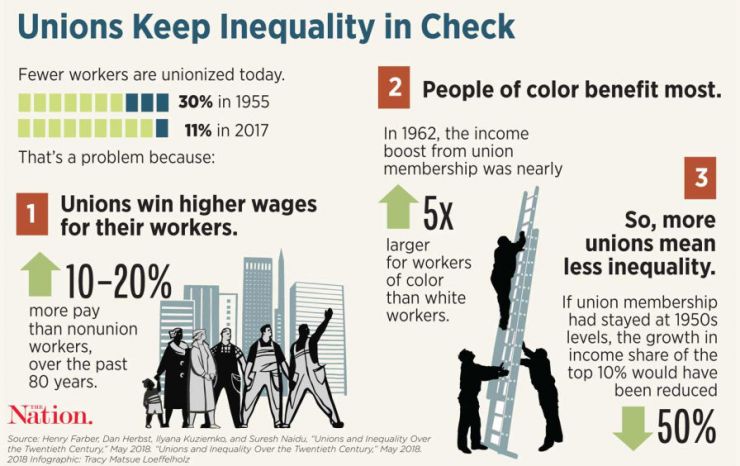There Is Power in a Union
May 23, 2018
Image by Tracy Matsue Loeffelholz, The Nation
Written by Mike Konczal, The Nation
A new study overturns economic orthodoxy and shows that unions reduce inequality.
For a period of 40 years, something managed to keep inequality in check in the United States. From 1940 to 1980, the richest 1 percent took home 9 percent of the wealth generated by the economy. Today, just as they did in the 1920s, the top 1 percent grabs about double that share. Surprisingly, the cause of this midcentury “Great Compression” has been largely neglected by economists, with many of them casually dismissing the role of unions.
One influential theory, especially among pundits, is that the supply of skilled workers curbed the growth of income inequality. Starting in the 1940s, the argument goes, the increasing education of the American workforce propelled a broad prosperity. Another recent account, associated with the economist Thomas Piketty, maintains that the devastation of World War II drove down the returns on capital.
But a groundbreaking new paper, “Unions and Inequality Over the Twentieth Century: New Evidence From Survey Data,” written by the economists Henry Farber, Dan Herbst, Ilyana Kuziemko, and Suresh Naidu, proposes a different engine for that broad prosperity: unions. The growth of union membership—to a height of nearly 30 percent in 1955, before falling to its current low of 10.7 percent—explains the Great Compression every bit as much as theories about education or any other single factor.
It may surprise some readers that economists consider the statement “unions help workers” a revelation akin to discovering general relativity. (Another recent finding, “where you grow up matters,” has also shaken the economics establishment to its core.) But economists haven’t had the necessary data to study unions in any depth. Detailed data on education goes back to the 1940s, but the government only introduced questions tracking union status in 1973. Yet the authors of “Unions and Inequality” newly applied a Gallup data set that allowed them to analyze workers back to the 1930s.
Before this paper, economists generally believed that unions largely helped the most skilled and educated workers—i.e., those who already had higher wages. Many economists insisted that unions work by creating insiders who benefit at the expense of outsiders—in other words, those who get in the union receive a premium, while those outside the union are denied opportunities. This theory implies that, since unions merely transfer wealth among workers, they wouldn’t lower inequality overall and might even slow economic growth. But the new paper pushes back on all these notions.
It turns out that, at their peak, unions were disproportionately made up of the least-skilled workers and people of color. Historians continue to debate how racially segregated unions were in this period, but this new research finds that nonwhites became more likely than whites to be in a union starting in the early 1940s, and that this trend continued until the late 1970s. (People of color also received a higher union premium.) This rise in union membership among people of color begins around 1941, when President Franklin Roosevelt desegregated the defense industry with Executive Order 8802, a move designed to stop a march on Washington planned by civil-rights leaders. As Suresh Naidu, one of the paper’s authors, told The Nation, “Starting around World War II, labor unions became no more likely to be white than the labor market as a whole. Union households would go on to become less likely to be white up and through the civil-rights movement.”
Most economists have also been wrong about unions and wealth distribution. If unions were largely about helping insiders at the expense of outsiders, they wouldn’t bring down every indicator of economic inequality—but that’s what happened with the Gini coefficient, the 90-to-10 ratio, and the rest of the jargon-heavy measures of inequality. The paper also reveals that decreasing inequality doesn’t reduce economic growth: The researchers couldn’t find a single model in which the economy slowed because of a high union share.
These results should end the simplistic tales in which education alone challenges the dominance of the 1 percent. If we want to change whom our economy works for, we must change who gets to exercise power. And this paper makes it clear: There is power in a union.


